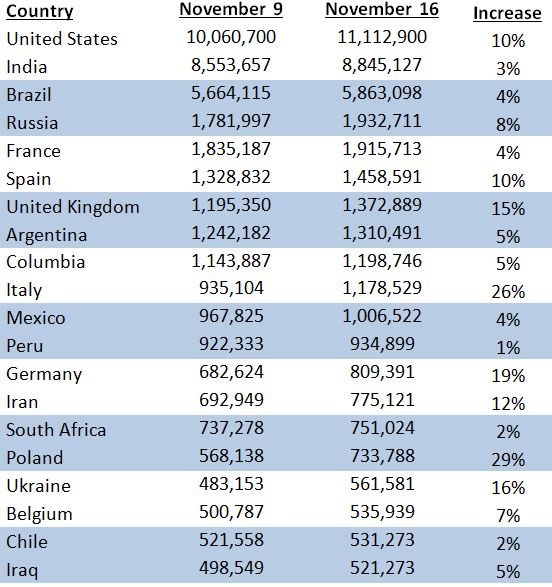November 16 COVID-19 Report
The surge in COVID-19 cases continues to grow as the coronavirus makes inroads across the northern hemisphere. U.S. and European numbers hit records last week, and U.S. hospitalizations due to COVID-19 climbed to 69,987.
Here is a look at the 20 countries with the highest number of cases, including their rate of case growth since last week:

Interestingly, Russia and France switched places in this week’s table of countries with the most cases as France has managed to cut the number of reported case rather dramatically. The UK, Mexico, Iran, and Belgium all moved up a slot. Both Italy and Mexico surpassed one million cases, bringing the total number of countries with in excess of one million cases to eleven. Germany jumped two spots and looks poised to break the one million barrier in the next week. The Ukraine soared three spots.
Europe seems to be splitting into two parts: Countries where cases are slowing, such as France, Spain, and the UK, and those that are still well into the double digit growth, like Germany, Italy, Poland and the Ukraine.
Meanwhile, the U.S. seems to be in that latter group as its rate of growth grew from 8 percent last week to 10 percent this week.
Second Wave is Building
It’s clear that the second wave of the global coronavirus pandemic is building in the U.S. and Europe, which as a group is surpassing the U.S. numbers. We’re not even into the coldest months of winter, but cases and deaths are growing across the Northern hemisphere.
The average number of cases reported in the U.S. in the past week was 145,000. That’s about five time as many cases per day as we saw in April when the first wave struck and more than twice as many cases as we saw when the virus peaked in July.
If we look back at the Spanish Flu that hit just over 100 years ago in 1918 through 1920, we see that the second wave, which hit in late 1918, was much worse than the first and accounted for more deaths than any of the four waves.
It is generally accepted that the mass movements of troops during World War One contributed to the spread, just as it is generally accepted that international travelers from China have spread the coronavirus from its early epicenter in Wuhan.
Like the Spanish Flu, the second wave of what is some call the Wuhan Flu may be worse than the first. It may also peak before Christmas and then bounce back upwards in the middle of winter.
The Spanish Flu Was Far Worse
The actual number of deaths due to the Spanish Flu is unknown, but the CDC reports that there were more than 50 million deaths worldwide. So far, COVID-19 has killed 1.3 million worldwide, making it far less deadly than the Spanish Flu. Still, deaths are ticking back upwards and hospitals are nearing capacity again. Even though doctors have gained valuable experience in treating COVID-19 patients and have new treatments available, deaths could still double before a vaccine is able to help curtail the virus.
One thing that made the second wave of the Spanish Flu more deadly than the first was that the virus mutated. As a result, killing those in their 20s and 30s, the prime of their health, instead of only the very young and the very old, like most flu seasons. It is believed this is because it caused a cytokine storm, something it shares with COVID-19.
The third and fourth waves of the Spanish Flu were not as deadly as the second, but were still worse than the first wave.
An estimated 500 million people, or one third of the world’s population, caught the Spanish Flu. Today’s equivalent would be 2.6 billion people. Given our much larger population, the 50 million who died then would be equivalent to 260 million today. It would be hard to see the 54 million cases and 1.3 million deaths growing by that much, especially as multiple vaccine candidates are promised to us as soon as next month.
Two Takeaways
We can learn two things from the Spanish Flu: First, we are lucky that COVID-19 is nowhere near as widespread nor as deadly as the Spanish Flye was, and second, we are still early in what might be a multi-year cycle. That means we need to be prepared for 2021 to be as bad or worse than 2020 was, both in terms of health, the economy, and socially.
The Spanish Flue also demonstrated that certain kinds of quarantines worked. The most effective were those that kept people who might be carrying the disease out of the country or city. This worked best for island nations that could enact a blockade.
We saw similar results in Alaska, which remained disease free for weeks during the initial outbreak. Unfortunately, once a virus like SARS-CoV-2 gets a foothold in an area, it is tough or even impossible to eradicate.
To put today’s numbers in perspective, you can look back at least week’s report, November 9: COVID-19 Cases Spike in U.S., Europe as Vaccine Hopes Soar.








